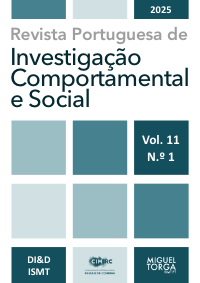Entre lágrimas e lutas: o papel das organizações no combate à violência doméstica
DOI:
https://doi.org/10.31211/rpics.2025.11.1.351Palavras-chave:
Violência Doméstica, Desigualdade de Gênero, Ambiente de Trabalho, Responsabilidade Organizacional, Políticas InstitucionaisResumo
Contexto: A violência doméstica, expressão da desigualdade de gênero que permeia tanto os espaços domésticos quanto os públicos, repercute-se nos cenário familiar e organizacional. As vivências relacionadas à violência, podem gerar sofrimento, comprometendo a capacidade de concentração e tomada de decisões, fundamentais em qualquer atividade profissional. Objetivo: Este estudo objetivou sistematizar a literatura empírica sobre o papel das organizações no combate à violência doméstica, integrando conhecimentos empíricos a um quadro teórico e a uma agenda de pesquisa. Métodos: Realizou-se inicialmente uma revisão bibliométrica na base de dados Scopus com o auxílio do software VOSviewer. Em seguida, com base no modelo 4W’s, conduziu-se uma revisão sistemática da literatura por meio das bases de dados Scopus e Web of Science. Resultados: Identificou-se uma tendência crescente na produção científica sobre o tema nos últimos anos, especialmente em publicações internacionais, com ênfase nos impactos multidimensionais da violência doméstica sobre o bem-estar e desempenho laboral de trabalhadores(as), incluindo sintomas físicos, psicológicos e emocionais. Conclusões: Os resultados destacam a urgência de medidas organizacionais proativas e da implementação de políticas específicas para enfrentar esta violência, enfatizando o ambiente de trabalho como um espaço crítico para o suporte social e o auxílio às vítimas, direcionando para a elaboração de um quadro teórico e uma agenda de pesquisa orientada à eficácia das ações corporativas contra a violência doméstica.
Downloads
Referências
Aeberhard-Hodges, J., & Mcferran, L. (2018). An International Labour Organization instrument on violence against women and men at work: The Australian influence. Journal of Industrial Relations, 60(2), 246–265. https://doi.org/gddz94
Adhia, A. Gelaye, B., Friedman, L. E., Marlow, L. Y., Mercy, J. A., & Williams, M. A. (2019) Workplace interventions for intimate partner violence: A systematic review. Journal of Workplace Behavioral Health, 34(3), 149–166. https://doi.org/pp97
Alves, F. de B., Paixão, G. dos S. & Martins, L. M. L. (2021). As projeções da violência doméstica: Um estudo a partir da interface entre desenvolvimento econômico e desenvolvimento humano. Revista Quaestio Iuris, 14(03), 1472–1499. https://doi.org/pp98
Asencios-Gonzalez, Z. Vara-Horna, A., McBride, J. B., Santi-Huaranca, I., Chafloque-Céspedes, R., & Díaz Rosillo, A. (2018). Factors associated with intimate partner economic violence against female micro-entrepreneurs in Peru. International Journal of Emerging Markets, 13(16), 1597–1614. https://doi.org/ghqrkc
Bhandari, P. (2020). Pre-marital relationships and violence: Experiences of working middle class women in Delhi. Gender, Place & Cultura, 27(1), 13–33. https://doi.org/pqbb
Brasil. (2006). Lei n° 11.340, de 7 de agosto de 2006. Cria mecanismos para coibir a violência doméstica e familiar contra a mulher. Diário da União. https://bit.ly/456teWm
Blodgett, C. & Lanigan, J. D. (2018). The prevalence and consequences of intimate partner violence intrusion in the workplace. Journal of Aggression, Maltreatment & Trauma, 27(1), 15–34. https://doi.org/pqbf
Carmichael, H., Steward, La., & Velopulos, C. G. (2019). It doesn't just happen to “other” people e an exploration of occupation and education level of women who die from intimate partner violence. The American Journal of Surgery, 218, 744–748. https://doi.org/gqpkv6
Carneiro, I. (2020). O processo de debate e a construção de direitos. Fundação Demócrito Rocha, Ceará. https://bit.ly/4dIwWaJ
Chang, T. Hu, Y., Taylor, D., & Quigley, B. M. (2022). The role of alcohol outlet visits derived from mobile phone location data in enhancing domestic violence prediction at the neighborhood level. Health and Place, 73, Artigo 102736. https://doi.org/pqbd
Chan-Serafin, S., Sanders, K., Wang, L., & Restubog, S. L. D. (2022). The adoption of human resource practices to support employees affected by intimate partner violence: Women representation in leadership matters. Human Resource Management, 62(5), 745–764. https://doi.org/gtgpc3
Çelebi, E., Pirincci, E., & Durmus, A. B. (2022). Exposure of married women to spousal violence: A community-based study in Eastern Turkey. Ulus Travma Acil Cerrahi Derg, 28(1), 1–9. https://doi.org/pqbg
Collins, P. H. (2000). Black feminist thought: Knowledge, consciousness, and the politics of empowerment (2.ª ed.). Routledge. https://doi.org/gqnwdf
Contreras, F., Puga, A. B., & Cortés-García, C. M. (2022) Impacto económico de la violencia de pareja: El caso de dos empresas colombianas. Estudios Gerenciales, 38(163), 172–183. https://doi.org/10.18046/j.estger.2022.163.485
Costa, M. F. (2018). A importância da intersecção entre gênero e fatores socioeconômicos para a elaboração de políticas públicas de enfrentamento à violência doméstica contra mulheres. Anais do V Simpósio Gêneros e Políticas Públicas, 5(1). https://doi.org/pqbj
Crenshaw, K. W. (1989). Demarginalizing the intersection of race and sex: A Black feminist critique of antidiscrimination doctrine, feminist theory and antiracist politics. University of Chicago Legal Forum, 1989(1), 139–167. https://bit.ly/43qRmBN
Deen, C. M., Restubog, S. L. D., Chen, Y., Garcia, P. R. J. M., He, Y., & Cayayan, P. L. T. (2021). To engage or to quit: Work consequences of intimate partner aggression and the buffering role of career adaptability. Journal of Vocational Behavior, 131, Artigo 103641. https://doi.org/gnhnkk
De Jonge, A. (2018). Corporate social responsability through a feminist lens: Domestic violence and the workplace in the 21st century. Journal of Business Ethics, 148(3), 471–487. https://www.jstor.org/stable/45022454
Duvury, N., Vara-Horna, A. & Chadha, M. C. (2022). Development and validation of lost days of labor productivity scale to evaluate the business cost of intimate partner violence. Journal of Interpersonal Violence, 37(5-6), 2912–2943. https://doi.org/pqbk
Echeverria, J. G. M., Oliveira, M. H. B. & Erthal, R. M. C. (2017). Violência doméstica e trabalho: Percepções de mulheres assistidas em um centro de atendimento à mulher. Saúde Debate, 14(spe2), 13–24. https://doi.org/pqbm
Galvão, T F., & Pereira, M. G. (2014). Revisões sistemáticas da literatura: Passos para sua elaboração. Epidemiologia e Serviços de Saúde, 23(1), 183–184. https://doi.org/ggsmc5
Gilligan, C. (1982). In a different voice: Psychological theory and women's development. Harvard University Press.
Harding, S. (1991). Whose science? Whose knowledge? Thinking from women's lives. Cornell University Press.
Harkin, D. (2019). Regulating private sector security provision for victims of domestic violence. Theoretical Criminology, 23(3), 415–432. https://doi.org/ghqrdz
Harkin, D. (2021). The uncertain commodity of ‘security’: Are private security companies ‘value for money’ for domestic violence services?. Journal of Criminology, 54(4), 521–538. https://doi.org/pqbn
Hesse-Biber, S. N. (2012). Feminist research: Exploring, interrogating, and transforming the interconnections of epistemology, methodology, and method. Em S. N. Hesse-Biber (Ed.), Handbook of feminist research: Theory and praxis (2.ª ed., pp. 2–26). SAGE Publications.
Lassiter, B. J., Bostain, N. S., & Lenz, C. (2018). Best practices for early bystander intervention training on workplace intimate partner violence and workplace bullying. Journal of Interpersonal Violence, 36(11-12), 5813–5837. https://doi.org/gfg3rt
Lee, K. A., Smith, M. E. & Bright, C. L. (2023). Intimate Partner Violence Perpetration Among Black Men: The Moderating Effect of Interpersonal Social Support. Journal of Interpersonal Violence, 38(13-14), 8542–8562. https://doi.org/ppxz
Leydesdorff, L., & Rafols, I. (2011). Indicators of the interdisciplinarity of journals: Diversity, centrality, and citations. Journal of Informetrics, 5(1), 87–100. https://doi.org/bhb23t
Page, M. J., McKenzie, J. E., Bossuyt, P. M., Boutron, I., Hoffmann, T. C., Mulrow, C. D., Shamseer, L., Tetzlaff, J. M., Akl, E. A., Brennan, S. E., Chou, R., Glanville, J., Grimshaw, J. M., Hróbjartsson, A., Lalu, M. M., Li, T., Loder, E. W., Mayo-Wilson, E., McDonald, S., … Moher, D. (2021). The PRISMA 2020 statement: An updated guideline for reporting systematic reviews. BMJ, 71. https://doi.org/gjkq9b
Pio, E., & Moore, G. (2022). Battered South‐Asian diasporic women: Culture, secrets and work. Gender, Work & Organization, 29(2), 536–560. https://doi.org/pp9w
Piosiadlo, L. C. M., Fonseca, R. M. G. S., & Gessner, R. (2014). Subalternidade de gênero: Refletindo sobre a vulnerabilidade para violência doméstica contra a mulher. Escola Anna Nery Revista de Enfermagem, 18(4). https://doi.org/ndm9
Quintero Arango, L. F. Q., Álvarez Agudelo, C. E., & Ibagon Parra, D. M. (2019). La violencia intrafamiliar en el desempeño laboral de las mujeres en el sector textil-confección. Diversitas: Perspectivas en Psicología, 15(2), 271–284. https://doi.org/g7bk6p
Rodrigues, A. F. O., & Raupp, F. M. (2020). Feminicídios íntimos e os custos econômicos: um estudo no âmbito de santa catarina. Sociedade, Contabilidade e Gestão, 15(3), 109–123. https://doi.org/pqbp
Rosado-Serrano, A., Paul, J., & Dikova, D. (2018). International franchising: A literature review and research agenda. Journal of Business Research, 85, 238–257. https://doi.org/gdxtw5
Ruggie, J. G. (2011). Guiding principles on business and human Rights: Implementing the United Nations “Protect, Respect and Remedy” framework. United Nations Human Rights Council. https://bit.ly/3ZbkVog
Saffioti, H. (2015). Gênero patriarcado violência (2.ª ed.). São Paulo: Expressão Popular.
Schneider, R. & Piazza, K. S. (2023). Does legal change induce behavioral change in domestic violence against women? Journal of Interpersonal Violence, 38(9-10), 6942–6960. https://doi.org/gsr57d
Shahriar, A. Z. M., & Shepherd, D. A. (2019). Violence against women and new venture initiation with microcredit: Self-efficacy, fear of failure, and disaster experiences. Journal of Business Venturing, 34, 1–18. https://doi.org/gf48bj
Silva, E. B., & Nascimento, R. P. (2022). Trabalho e violência doméstica: Uma investigação a partir de grupos de apoio às vítimas no Facebook. Cadernos EBAPE.BR, 20(5), 675–687. https://doi.org/ndm4
Wagner, C. S., Roessner, J. D., Bobb, K., Klein, J. T., Boyack, K. W., Keyton, J., Rafols, I., & Börner, K. (2011). Approaches to understanding and measuring interdisciplinary scientific research (IDR): A review of the literature. Journal of Informetrics, 5(1), 14–26. https://doi.org/d47p2w
Weatherall, R., Gavin, M., & Thorburn, N. (2021). Safeguarding women at work? Lessons from Aotearoa New Zealand on effectively implementing domestic violence policies. Journal of Industrial Relations, 63(4), 568–590. https://doi.org/gkfhdn
Weziak-Bialowoska, D. W., Bialowolski, P., & Mcneely, E. (2020). The impact of workplace harassment and domestic violence on work outcomes in the developing world. World Development, 126, 1–11. https://doi.org/gnntdh
Wibberley, G. Bennett, T., Jones, C., & Hollinrake, A. (2018). The role of trade unions in supporting victims of domestic violence in the workplace. Industrial Relations Journal, 49(1), 69–85. https://doi.org/gq2s2r
Wilcox, T. Greenwood, M., Pullen, A., O’Leary Kelly, A., & Jones, D. (2021). Interfaces of domestic violence and organization: Gendered violence and inequality. Feminist Frontiers, 28, 701–721. https://doi.org/gq2sz9
Williamson, S., Colley, L., & Foley, M. (2019). Human resource devolution, decoupling and incoherence: How line managers manage gender equality reforms. Public Management Review, 22(5), 1–17. https://doi.org/pp9x
Yates, S. (2019). “An exercise in careful diplomacy”: Talking about alcohol, drugs and family violence. Policy Design and Practice, 2(3), 258–274. https://doi.org/pqbq
Zafar, S., Zia, S., & Amir-Ud-Din, R. (2022). Troubling trade-offs between women’s work and intimate partner violence: Evidence from 19 developing countries. Journal of Interpersonal Violence, 37(17-18), 16180–16205. https://doi.org/gkg6kd
Downloads
Publicado
Como Citar
Edição
Secção
Licença
Direitos de Autor (c) 2025 Larisse Oliveira Amorim, Leonardo Victor de Sá Pinheiro, Fabiana Pinto de Almeida Bizarria, Marcleide Sampaio Oliveira

Este trabalho encontra-se publicado com a Creative Commons Atribuição-NãoComercial 4.0.
Os autores conservam os direitos de autor e concedem à revista o direito de primeira publicação, com o trabalho simultaneamente licenciado sob a Creative Commons - Atribuição-NãoComercial 4.0 Internacional que permite a partilha do trabalho com reconhecimento da autoria e publicação inicial nesta revista.












